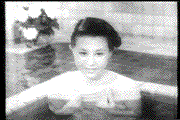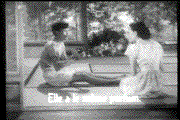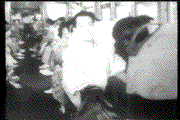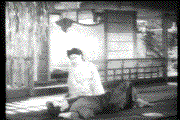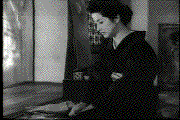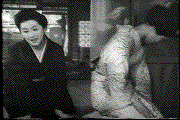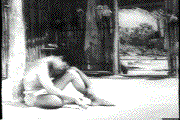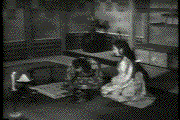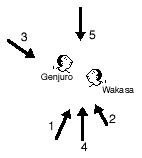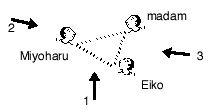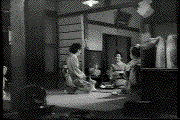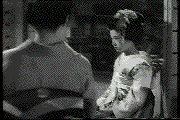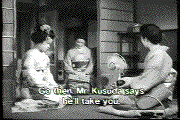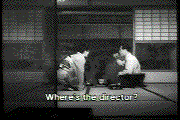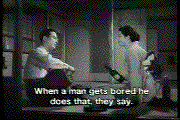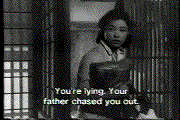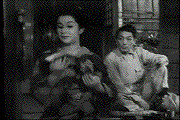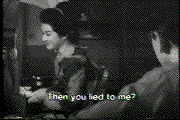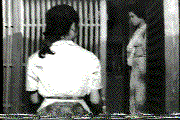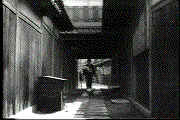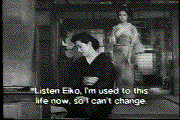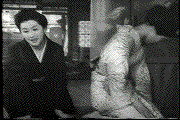Uploaded 1 December 2001
How inadequate I feel, watching Kenji Mizoguchi’s movies! I want to feel closer to his people, the way I feel close to John Ford’s cowboys, Jean Renoir’s cancan dancers, Carl Dreyer’s bigots, F.W. Murnau’s Polynesians, King Vidor’s blacks, Roberto Rossellini’s partisans – any of whom feel no less “alien” to me than Mizoguchi’s Japanese, medieval or modern. It is not a “cultural divide” that makes me feel like a distant observer.
Of course I feel inadequate not understanding a word of Japanese; I don’t even relate well to its intonations or songs. Of course I feel inadequate peering at players placed so far from the camera in prints so dupey that their faces are white smears, without visible expression.
But there is no difficulty for me with Mizoguchi’s pictures, his compositions, his blocking of characters, his use of body language, his long takes, his instrumental music, or with the conflicts, emotions, themes and philosophy of his cinema. There is no doubt that Mizoguchi, even though his subjects were all but exclusively Japanese, conceived his work also in the expressionistic traditions of Western cinema and French romantic naturalism, and as an expression of outrage rather than affection for traditional Japanese culture. Had Mizoguchi not been Japanese, his movies would probably be labeled “anti-Japanese.”
I suspect that I do not feel closer to Mizoguchi’s people because his is a cinema in which artifice is not only the style but the theme, and the search for authenticity the obsession. I do not feel closer to Mizoguchi’s people because often they are not quite “there” on the screen, but are sought for, and are themselves characters in search of an author, as in Pirandello.
There are two aspects of this cinema: cutting and everything else.
Part 1: Everything Else
Yuki fujin ezu (Madame Yuki, Japan 1950) starts off, like most Mizoguchi movies (and most Ford movies) with someone arriving: Hamako, a young woman arrives from the country to serve the glamorous and aristocratic Lady Yuki, whom she has adored from a distance since childhood. And few beginnings could be more inviting than the prospect of Mizoguchi doing a movie with so delightful and serious an ingénue as Yoshiko Kuga. One anticipates something akin to what Max Ophüls and Alfred Hitchcock did with Joan Fontaine, in Letter From An Unknown Woman (US 1948) and Rebecca(US 1940). Indeed, we start out that way, with Hamako gazing in wonder in every shot, as we tour Yuki’s country estate with her. Left alone for a moment in a hallway, she cannot help staring up and down and all around. Mizoguchi even treats us to her interior monologue, voice-over, as she takes a bath, a bit as Vidor would do with Audrey Hepburn in War and Peace (US/Italy 1956).
But Mizoguchi, having seduced us, immediately denies us. He cuts us away from Hamako to see what she is seeing, and in the next scene, as she chats with Seitaro, we cannot even feel her impressions, because Mizoguchi puts her too distant to be seen: she is there just to listen.
A bus and train ride start out as her experience, but her companion Kikunaka takes over her scenes, and eventually Yuki does the same. Hamako, no longer our associate, has become a supporting player of no significance, a “person” no more, compelled by Mizoguchi to turn her back to us. She has one more good scene, when Yuki’s husband forces her to come into his bedroom while he has sex with Yuki, after which Mizoguchi dumps her deliberately into long shot sweeping a broom, with Kikunaka and the housekeeper saying “tsk tsk” and changing the subject. In effect, all the magical scenes of Hamako’s fascination have served merely to set the stage for Yuki herself.
And then Yuki turns out to be a nonentity! Like Citizen Kane. And Kikunaka too turns out a nonentity, without will or substance, as is Yuki’s husband, who is gross and repulsive to boot. Degenerate aristocrats all. Why has Mizoguchi deprived us of Hamako, who, in Yoshiko Kuga, radiates so much essence with so little effort and so much grace? Michiyo Kogure, in contrast, incarnates Yuki as a void, her energy drawing inward, an addict of her own nothingness, who can find no higher purpose than her own extinction. Her response to pregnancy is to dissolve herself in the floating mists of the lakeside, then in the lake itself. Whereupon Hamako – speaking for the women of postwar Japan but now relegated to long shots almost infinitely distant – denounces her erstwhile hero: “Madame Yuki, woman without courage!” Why does Mizoguchi not let us see Hamako’s face?
The best American movies are character driven, meaning that events, like plot, lighting and staging, are concocted to further our interests in the character. If the movie should happen to tell us about Napoleon’s invasion of Russia or some other event, and should the movie also meditate like Tolstoy upon all sorts of issues of love, morality and fate, so much the better; but the value of any of these matters will depend on their emotional value to the characters.
Not in Mizoguchi. In his cinema what counts is the deed.
Youth is always denouncing age in Mizoguchi. Youths tell us aristocrats have had their day also in Shin Heike monogatari (New Tales of the Taira Clan, Japan 1953), and that time it is the twelfth century. It is hard to think of a Mizoguchi movie in which women do not denounce their helplessness and men are not brutes – and equally helpless. It is always a time in Japan when, as the credits of Sansho dayu (Sansho the bailiff, Japan 1954) inform us, people have “yet to awaken as human being”. Yuki perhaps associates a strong patriarch with her lost childhood identity and for this reason is powerless against her husband. Hamako’s denunciation of Yuki thus has an eternal, even a generic quality that, for Mizoguchi, renders Hamako irrelevant as an individual, except in her deed.
Ironically, an actor of Yoshiko Kuga’s quality is exceptional in Mizoguchi’s movies precisely because she gives her characters such definitive individuality. She becomes a character physically and mentally to such an extent that it is impossible, while watching her in one part, to think of her in another – in Mizoguchi’s Shin Heike monogatari and Uwasa no onna (The Woman of Rumour, Japan 1954); Yasujiro Ozu’s Ohayu (Good Morning, Japan 1959); Akira Kurosawa’s Yoidore tenshi (Drunken Angel, Japan 1948) or Hakuchi(The Idiot, Japan 1951); or in her movies for Masaki Kobayashi, Kon Ichikawa or Nagisa Oshima.
In contrast to Kuga, Mizoguchi’s actors usually have a commedia dell’arte side to them, a Pirandellian awareness of playing, and of playing within a stock role. Thus the theme of artifice. It seems the besetting sin in Mizoguchi’s Japan that everyone is always assuming a role, and a posture appropriate to it, and that personalities and names and clothing and social position are nothing but constructs concealing nonentities and voids. Some characters search for identity (the heroes of Sansho dayu and Shin Heike monogatari), most others seek to assume one, and still others, like Yuki or Oharu in Saikaku ichidai onna (The Life of Oharu, Japan 1952) seem never to have formed personalities beyond memories of childhood – like Robert Bresson’s donkey Balthazar (in Au hasard, Balthazar [France 1966]), except that everyone is a donkey in Mizoguchi, brunts of the world’s cruelty, not yet human, just constructs.
Evil is systemic in Mizoguchi, not individual: we have not “awakened” yet. Thus the actors seem to be speaking to us, not just to each other, and are not afraid to be hammy, like Chaplin; they come alive flirting with us; they circle constantly around each other, playing to us, telling us – like commedia, Brecht and Chaplin – that social constructs are persecutive rather than preserving.
Tradition is for the most part institutionalized brutality. A tea ceremony in Gion bayashi (Japan 1953) is the subject of one of Mizoguchi’s loveliest shots, but the tea ceremony is being staged by the madam of a geisha house, as part of a school for adolescent girls training to be prostitutes, as a demonstration of Japan’s successful selling of itself to foreign tourists. Family relationships are constructed with similar corruption: in Chikamitsu monogatari (A Story by Chikamitsu, Japan 1954), a mother who has to sell her daughter to avoid bankruptcy is terrorized by the idea that the daughter might kill herself and not because she loves her daughter, but because the scandal would demolish the family. Meanwhile the daughter (though fleeing for her life), is dutifully sending borrowed money to the mother, who through fear, denounces her daughter to the police. The daughter is put her to death by the police – on a cross – for the crime of love, even though the love is chaste.
Virtually every relationship in Mizoguchi is humiliating, hierarchal, enslaving, with space expressing the power of one person, the nullity of another: endless bowing and kowtowing and scraping across floors in self-abasement. And despite all these shots of people walking in rooms and passageways, we get no sense from Mizoguchi of what it is like to be in these houses, because these are sets, designs, formed of rectangles, cubes, lines and blocks, and their space is fictive, part of the nightmare of power. The grace of the architecture, the clear lines of buildings, the comforting sensation of a storybook Zen order radiated by structures, all are geometric forces of imprisonment and oppression, owing as much to Caligari as to Japanese tradition.
Percussive soundtracks often echo the geometry of sets. Even Mizoguchi’s exteriors are constructed: the famous fog-covered lakes in Ugetsu monogatari (Ugetsu, Japan 1953) and Yuki fujin ezu, sparking ponds in Yuki and Sansho, country streams and villages that echo Dutch landscapes in Utamaro o meguru gonin no onna(Utamaro and his Five Women, Japan 1946). Reality is subjective, emotionalized. Movies are basically atmosphere, Mizoguchi maintained, citing Vermeer.
At times Mizoguchi’s Japan is not much different than Dreyer’s Denmark, where witches are burned in Day of Wrath (Denmark 1943) and the dead resurrected in Ordet (Denmark 1955), apparently for no other reason than the quality of the light. As for the really “real world”, it is like freedom or love or liberty – something beyond reach: heaven.
If tradition sustains or inspires, it does so as hope: a reverence for keeping troth to father’s “words”. Anju sacrifices herself by drowning, in Sansho dayu, in order that Zushio fulfill father’s words. After passing through a gate where streaked light suggests infinity beyond, in a pool of water whose ripples spread those “words” outward in a movement echoed an hour later by the ever-retreating movement of the camera while Zushio messianically liberates the slaves, moving grandly outward until at last he learns of his sister’s deed, of which his great deed has been merely the end point of the ripple. Similarly motivated is Kyomori’s defense of his father in Shin Heike monogatari (after resolving the crisis of which man is his father); the devotion of the forty-seven samurai in Genroku chushingura (A Tale of Loyal Retainers in the Genroku era aka The 47 Ronin, Japan 1941) and of Mohei in Chikamatsu monogatari; the heroism of Okita in Utamaro; the fortitude of Munechika in Gubijinso (Poppies, Japan 1935); the grave offering by the little boy at the end of Ugetsu. In all cases, keeping troth means doing a deed. Self identity is one’s deed. “Personality” is a void. We construct ourselves according to father’s words and devote ourselves samurai-like to single-minded accomplishment of ideological purpose.
Thus, on one level there is no difference in Sansho dayu between the slaver and the liberator: the slaver’s refusal to feel pity for the slaves he brands with an hot iron is also founded on purity toward a father’s words. Thus the self-consciously Pirandellian side to these people, beautifully exemplified not simply in the ease with which Zushio switches his pose from slave to imperial governor without a blink, but even more in his contempt for poses – the Pirandellian enslavement to artifice, to the need to put on a face in society in order to survive or command – and employs authority against itself. But Zushio is capable of doing all this only because he realises that he himself is nothing: it is his deeds which count. Contrariwise, if Hakamo disappears from our view in Yuki, it is simply because she no longer has anything to do.
Mizoguchi’s heroes are few and exceptional; they remind us that most people are cogs in the system, equally brutal and terrorized. It seems like a Brechtian joke, in The Life of Oharu, when someone is arrested for counterfeiting in this geisha-like world where every relationship is counterfeited and the only authentic emotion is fear; the entire movie is an iconoclastic rage against all authority, power, position, and manner. Thus Mizoguchi’s great themes are the great passions: love, duty, honor, and suicide. And petty ones: money and greed. The people he concentrates on are obsessive, even hysterical in their needs, like Balzac’s demonic profligates – Goriot, Hulot, Eugènie Grandet. Heroes like Zushio and Kyomori move their bodies as though propelled by coiled springs. But Yuki and her husband sink deeper and deeper into languidness. Villains are as extravagant as the heroes, seeming far beyond redemption, creatures of melodrama and commedia, if not Punch and Judy. And yet only a few days before liberating the slaves, Zushio was such a brutish cog himself, branding an old man with hot irons, pitilessly. He had not “awakened”.
“Describe for me the implacable”, Mizoguchi once instructed his longtime scenarist Yoshikata Yoda, at the time of Naniwa hika(Osaka Story, Japan 1936). “Describe for me the implacable, the egotistic, the sensual, the cruel…There are none but disgusting people in this world”. Naturalistic melodrama was the ideal: “everything has to be crystallised, concentrated… You have to write a great work, like Balzac, Stendhal, Victor Hugo or Dostoyevsky”. [1]
If “acting” of the quality of Yoshiko Kuga’s is exceptional in Mizoguchi, it is maybe because she is so successful in constructing new persons for herself, and is thus the ultimate justification, at least artistically, of the very system of artifice that Mizoguchi is intent on denouncing. Performance styles that are more self-doubting, more “Brechtian”, better signal the artifice of social repression, and the primacy of deed over personality. Mizoguchi’s interest is less in the individual than in the design containing the individual, the design which both defines and restrains, from which there is always the danger that the individual will burst out, and do cosmic violence to the design. And yet, it is only when the deepest emotions burst through the Caligari-esque constructions that moral innovation redeems the intolerable regimentation of life.
Mizoguchi’s interest in icons and in designs containing individuals, produces many of his magic moments. His players have only to pose, as here in Gion Bayashi. And long shots often only amplify their emotion. Murnau’s awesome influence is evident in this sort of body language; compare, for example, this model of despondency in Murnau’s Tabu (US 1931). And William Wyler, whom Mizoguchi admired, began Dodsworth (US 1936) similarly.
In Uwasa no onna a prostitute need only lean against a post for all her emotions to be plain. In Saikaku ichidai onna, the suffering of Oharu staring desperately for a peek at her son depends equally on posing. One could cite hundreds of similar moments. Their pathos is external, however – a conflict between them and the world. Whereas what gives Genroku chushingura such surprising excitement and power – despite its three-hour-thirty-six-minutes duration and only one hundred and sixty shots virtually without action – is that the conflict is internal. Not only is much of the “acting” modeling, but the conflict between actor and model is clear, and this is the drama. Long takes contain the tension, as do the cubes and rectangles, and like time, amplify it beyond endurance.
The conflict begins in 1701 when Lord Kira provokes Lord Asano into attacking him during a court ceremony. For this sacrilege, Asano is sentenced to hara-kiri and his house is suppressed. Asano’s family and followers agree with the justice of this sentence, because they are obeisant to order. But their samurai codes demand that Kira also be condemned, else there is no order; the emperor as well regrets Asano’s attack failed. The conflict of orders is resolved by Asano’s forty-seven samurai killing Kira, placing his head on Asano’s tomb, and committing hara-kiri on themselves. Thus is revolution from within. Their deed inspires the suppression of Kira’s house and establishes a moral innovation, like Zushio’s liberation of the slaves in Sansho dayu.
At the same time, it exacts a heavy personal toll, prompting us to wonder how much possibility there is for a society whose most virtuous citizens feel obliged to kill themselves. Critics are forever writing that Genroku chushingura, made at enormous expense during World War II, exalts militarism, obedience even to death, subservience of individuality to a code of honor, and thus Japan’s fascistic war. But when, nine years after Hiroshima, in Sansho dayu, Anju walks calmly into the water so that her brother may escape to bear troth to father’s words, no critic charges a continuance of fascist sentiment. In fact, deliberated suicidal actions are endemic in Mizoguchi in the decade after the war: Utamaro, Yuki fujin ezu, Oyu-sama (Miss Oyu, Japan 1951), Musashino fujin, Sansho dayu, Chikamatsu monogatari and Shin Heike monogatari. And, as in Genroku chushingura, suicide is always a protest against the prevailing order, and justified as necessary to purify that order, to “turn the lie into truth”, as a young woman who elects to join the mass hara-kiri of the forty-seven samurai puts it.
Mizoguchi leaves out the blood. Perhaps it is immoral for him not to make us watch the actual murder of Kira in horrifying detail, so that we may see what all this fine abstract talk actually comes down to. But neither do we see the disembowellings. It is not pain they fear, or death, which are too negligible to count on the moral ledger; what they fear, like Christians awaiting the lions, is that they may flinch (as Asano did). “Keeping up [courage] is much harder than one would think”, Oishi remarks. This is what is tearjerking. This is the tension Mizoguchi’s long takes extend. At every moment we can see the actor threatening to destroy the model, the individual almost breaking through the ritual. It is because they have lost everything and cannot control themselves that these people impose iron discipline on themselves. Asano’s wife cutting her hair in mourning solidarity with perfect grace and style is passion raw, like Dreyer’s Joan.
Theirs is not, as some have claimed, a conflict of duty and feeling (giri versus ninjo). Oishi’s deed is his feeling, his identity, his self. The unbearable feeling is the fear of not keeping troth. These are love stories: Oishi was Asano’s companion since boyhood; the young woman cannot not join her fiancé. And in both cases these suicidal lovers “correct” their loved ones’ failures, turning lie into truth.
Scorn for troth, accordingly, regularly incites Mizoguchi’s people to erupt in violence. In Uwasa no onna, Yukiko (Yoshiko Kuga) is as placid as a sheep, until she goes after her two-timing lover with a pair of scissors. Mizoguchi loathes two-timers also in Gubijinso, Naniwa ereji (Japan 1936), Gion no shimai (Sisters of Gion, Japan 1936), Utamaro, Yuki fujin ezu, Oyu-sama, Musashino fujin (Lady Musashino, Japan 1951), and Ugetsu (and I can account for only twenty-one of Mizoguchi’s eighty-five features). Utamaro is almost a remake of Genroku chushingura: Okita justifies her murder of her two-timing lover as keeping troth to herself, for which, just like the forty-seven samurai, she is willing to accept the legal consequences, and all around her applaud; an aristocratic woman declares that now she knows the path a woman must follow, and the artist Utamaro, overwhelmed by Okita’s mythos in the same way as centuries of Japanese poets at the mythos of the forty-seven samurai, exclaims: “I want to draw [her]!”.
Part 2: Cutting
It is this language, and not Japanese, that has to be learned to understand “Mizoguchi”.
– Jacques Rivette, speaking of mise en scène [2]
The succession of shots below, from Gubijinso, would never have been permitted to leave the cutting rooms of any Western film company, and yet they are typical of Mizoguchi not only here in 1935 but all of his career.
1.  2.
2. 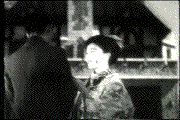 3.
3. 
4. 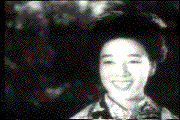 5.
5.  6.
6. 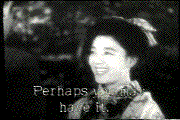
In America or Europe, the camera placement for the six shots would be as diagrammed below:
Whereas what Mizoguchi does is this:
Mizoguchi’s shots do not “go together”: each cut is disruptive, at an angle unexpected, requiring each time that we orient ourselves anew. The Western way would not jump to a lower angle for shot 2, or shift for no apparent reason to behind the characters’ backs for shots 2, 3 and 5, then jumping back to their fronts for shots 4 and 6. The Western way would have preserved the characters’ emotional spaces, allowing us to experience their feelings as they gaze at each other and exchange gazes. In Mizoguchi, in contrast, the shifting compositions suggest the boy and girl are posing for us rather than for each other. Mizoguchi looks for the most romantic way of composing, pictorially, each stage of their conversation, as separate events, and the result is exciting and delightful, much worth running and re-running for itself. But it keeps placing us newly outside the characters, in favor of their deeds. Mizoguchi’s shifting perspective resembles the way Humphrey Jennings jumbles surrealistically divergent images of Britain during the Blitz, except that Jennings cuts all over England, whereas Mizoguchi cuts around a love scene.
Somewhat similarly, Mizoguchi jumps all over the compass in Genroku chushingura during the long conversation between Oishi and the young woman, and in Ugetsu, high and low as well, while Genjuro is seduced by the phantom enchantress:
Naturally a conversation between three people in Gion bayashi is viewed from three perspectives – something which has probably never occurred in an American movie:
For Mizoguchi, it is absolutely the norm to “cut across the axis” so that characters exchange position in the frame, but even though “cutting across the axis” is technically the correct term for a procedure which, in the West, every editor is taught to avoid, it is not an appropriate description for Mizoguchi’s style.
Imagine a big floor-map of North America, and place a couple in the middle. The Western way would keep the camera in Mexico, shifting right or left to the boy or girl, or showing both together, within a coherent perspective. Mizoguchi might start in Mexico, but would then switch to Canada, and might add a shot from Hawaii. In this way he disrupts not only our empathy with the characters, but also the dialectical (or conversational) mode of Western cinema. Instead, by shifting up, down, and all around, Mizoguchi wraps his characters within a community, enclosing space which is essentially shared space. This is one reason it is difficult for us to figure out the layout of his houses and rooms, and why space in his movies seems so fictive and to relate more to design and psychology than to reality. It is not that Mizoguchi is deliberately “cutting across the axis” and confusing us spatially. It is that he encloses the space physically, within his narration. Because it is deeds that count, not individuals, and Mizoguchi’s conception of space favors the deed, not the individual. A bit like Rossellini, Mizoguchi gives us the illusion that events are occurring beyond his intervention and that he is trying to film them. Thus he keeps us further outside a character than we are used to – or than we want to be, in the case of Yoshiko Kuga especially! But the result, as Fred Camper puts it, is that “the relationship between an individual and his culture is in part the result of the way we see space itself”.[3]
Gion bayashi is an unusual Mizoguchi movie in its concentration on two women who want to be the protagonists of their lives, in contrast to Oharu in Saikaku ichidai onna and most of the director’s ladies in distress, who are abused objects viewed in long shot. But Mizoguchi’s cutting transforms the sort of empathetic relationships we form in Western cinema.
When sixteen year old Eiko first arrives at the geisha Miyoharu’s house, she opens the slatted gate, a geometry marking her application to be a geisha, and hears Miyoharu talking with a client:
Miyoharu: I hate people like you. You owe all this money. Still
you come to play around with the geisha. You should only go
to a geisha house when you have money.
Client: But I want to marry you. That’s not playing around with
a geisha.
Miyoharu: I have no intention of marrying you.
Client: Then you lied to me?
Miyoharu: Geisha don’t lie, they talk business. Don’t you
know that we just agree with everything? …Work and pay
your debts. Then we can meet again.
But the shot that follows – of Miyoharu and her client – is not from Eiko’s perspective, as it would be in any American or European movie. Why?
Because the scene gives Eiko a false definition of geisha life as woman power. Eiko envisions Miyoharu and herself as liberated, postwar women with Constitutional rights to inspect and reject clients, to take their money, and not to fall in love. Eiko, like Gigi, sets out to become a geisha oblivious to fatality not only in the world but in her own character; one of Mizoguchi’s more magical sequences follows her wonder and delight as she dresses for her first day, scampers across Kyoto, and nods happily during her hairdresser’s wisdom:
Maiko always come here their first day. I bet you were so
happy, you couldn’t sleep last night. It’s all business from
now on. You have to look your prettiest. [Eiko nods yes!] But
don’t fall in love, that’s bad. [Eiko nods yes!].
Later she banters: “Obligation? Love? I don’t know anything about that…. Men ought to serve us”.
Returning to Miyoharu and her client: the sharp American-style crosscut in the middle of their dispute is the only such cut in the movie until the end, when Eiko’s education will be completed in a similar crosscut with Miyoharu, who then again will spin around to incarnate in motion a rebuke – a device typical of expressionist moviemakers:
At film’s end, Eiko rebels –
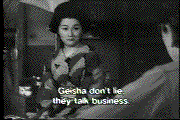
Shot 1: Eiko: Everyone lies. Kyoto’s geisha, Maiko, it’s all lies. If you sell yourself well, you succeed. Otherwise, like me, you’re locked out…
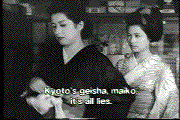
shot 2: Eiko: …If I cannot live without selling myself, I’ll quit. -[whereupon Miyoharu spins around in rebuke, then retreats]:
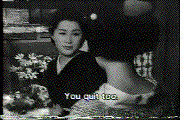
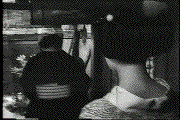
shot 3: And once again, as at film’s beginning, Eiko stares
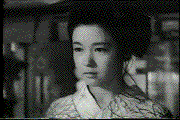
shot 4: – but does not see: [the shot that follows of Miyoharu is not from Eiko’s perspective] –
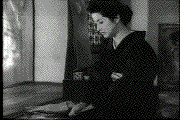
shot 5: – as is clarified by the next shot:

shot 6: Instead of giving us the cross cut we expect to rhyme with shot 4, Mizoguchi has simply pulled back his camera in shot 5, enclosing his characters’ space rather than placing the camera between them, maintaining his own angle, not switching to Eiko’s.
This sequence also began like the film’s opening sequence, with the slatted gate, but this time the gate closes on Eiko.
And Miyoharu, returning home after being compelled to have sex against her will, appears imprisoned in
Mizoguchi’s Caligari-like set. And no sooner is she home, than she is set upon by Eiko’s rebukes, as Mizoguchi’s high angle geometrically details (Eiko is on top, Miyoharu her victim):
This high angle (of Eiko and Miyoharu) appropriately echoes the high angle (of Kanzaki and Miyoharu) which Mizoguchi used in the scene, just before this one, of Miyoharu’s humiliating prostitution.
Miyoharu was forced to prostitution because otherwise she and Eiko were barred from employment as geishas and, more to the point, because Eiko would have been raped by one of the bosses. Miyoharu thus finds herself in a position similar to Dr. Cartwright’s (Anne Bancroft) in John Ford’s 7 Women (US 1966), who also walks a dark corridor on a similar prostitutional mission to save her friends.
But Ford emphasizes Cartwright’s courage and fear, whereas Mizoguchi’s high angle over Miyoharu (with Kanzaki) emphasizes her victimization – and anticipates the high angle of Eiko’s damning condescension toward her in the subsequent scene.
But all high angles show victims in Mizoguchi’s cinema, where everyone is eternally bowing or low or raising themselves on platforms. Thus, the high angle of Miyoharu over Kanzaki places Kanzaki, Miyoharu’s apparent persecutor, in his position as an even lower victim of the same ridiculous artifice. And the high angle of Eiko over Miyoharu, shows Eiko also as victim. No one is on top.
And Eiko cannot be saved. The nature of the geisha system, as explained by Miyoharu at film’s beginning, is exploitation and power – whether of geisha over client, or client over geisha. Miyoharu’s prostitution only reinforces the system. Now she wants to be Eiko’s protector, preserving her from prostitutional sex as a sort-of Constitutional prostitute, in effect working for Eiko, who is thus, through the matching high angles, appropriately compared to Kanzaki as part of the corruption of power.
Returning to the confrontation between Eiko and Miyoharu, shot 6 continues as Eiko, finally breaking out of her dollhouse, recognizes her corruption to power, and runs away to the rear of the frame:

shot 7: With one of his Mexico-Canada crosscuts, Mizoguchi enclose their space, and then echoes the expansion of space between shots 5 and 6, by pulling back his camera to shot 8.
Eiko has retreated from Miyoharu, and from the realities of a cruel world that forces us to assume roles which are not of our choosing, to become cruel ourselves, to corrupt our consciousnesses, so that ultimately our selves (like Madame Yuki) have no existence, no deed. The nature of the geisha (like that of the lady) is to be a doll with no more personality than a doll: a void. Mizoguchi’s postwar women think they can change this. In Josei no shori (The Victory of Women, Japan 1946), a female attorney actually declares that her opponent’s “formalism makes his point void”. She is arguing more from Mizoguchi’s sense of the world as misdesign than from tradition. Change costs dear. Mizoguchi’s revolutionaries are all Christ figures, who sacrifice themselves. “What good does it do you to face the world proudly?” asks one of Eiko’s predecessors in Gion no shimai. None of the forty-seven samurai are there to reply.
To all of this, Miyoharu replies with compassion. Her compassion is expressed is the actors’ Tabu-like body language in shot 8: Eiko a figure of defeat; Miyoharu a pietà who has failed to save her child from life.
And Miyoharu’s compassion is expressed also in the movement within the shot. Miyoharu coming forward from the rear of the frame to the proscenium – to us – continues the same coming-forward movement begun in the transition from shot 7 to shot 8. It is this movement by which Miyoharu’s compassion replies to Eiko’s despair. It is the deed that counts.
And thus Mizoguchi’s shifting camera – the freedom of his point of view – annuls the constrictions of constructed space. We are free.
Footnotes
[1] Ariane Mnouchkine, “Six entretiens autour de Mizoguchi”, Cahiers du cinema 158 (August 1964): 24, 26.
[2] Jacques Rivette, “Mizoguchi viewed from here”, in Jim Hillier (ed), Cahiers du cinema volume 1 – The 1950s: Neo-Realism, Hollywood, New Wave (London: Routledge & Kegan Paul, 1985), 264.
[3] Fred Camper, “Adventures in space: the loyal 47 ronin“, Chicago Reader (7 February 1997).http://www.chicagoreader.com/movies/archives/0297/02077.html.

